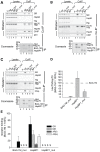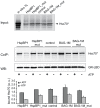Hsp70 cochaperones HspBP1 and BAG-1M differentially regulate steroid hormone receptor function
- PMID: 24454860
- PMCID: PMC3891853
- DOI: 10.1371/journal.pone.0085415
Hsp70 cochaperones HspBP1 and BAG-1M differentially regulate steroid hormone receptor function
Abstract
Hsp70 binding protein 1 (HspBP1) and Bcl2-associated athanogene 1 (BAG-1), the functional orthologous nucleotide exchange factors of the heat shock protein 70 kilodalton (Hsc70/Hsp70) chaperones, catalyze the release of ADP from Hsp70 while inducing different conformational changes of the ATPase domain of Hsp70. An appropriate exchange rate of ADP/ATP is crucial for chaperone-dependent protein folding processes. Among Hsp70 client proteins are steroid receptors such as the glucocorticoid receptor (GR), the mineralocorticoid receptor (MR), and the androgen receptor (AR). BAG-1 diversely affects steroid receptor activity, while to date the influence of HspBP1 on steroid receptor function is mostly unknown. Here, we compared the influence of HspBP1 and BAG-1M on Hsp70-mediated steroid receptor folding complexes and steroid receptor activity. Coimmunoprecipitation studies indicated preferential binding of Hsp40 and the steroid receptors to BAG-1M as compared to HspBP1. Furthermore, Hsp70 binding to the ligand-binding domain of GR was reduced in the presence of HspBP1 but not in the presence of BAG-1M as shown by pull-down assays. Reporter gene experiments revealed an inhibitory effect on GR, MR, and AR at a wide range of HspBP1 protein levels and at hormone concentrations at or approaching saturation. BAG-1M exhibited a transition from stimulatory effects at low BAG-1M levels to inhibitory effects at higher BAG-1M levels. Overall, BAG-1M and HspBP1 had differential impacts on the dynamic composition of steroid receptor folding complexes and on receptor function with important implications for steroid receptor physiology.
Conflict of interest statement
Figures





Similar articles
-
BAG-1 diversely affects steroid receptor activity.Biochem J. 2012 Jan 1;441(1):297-303. doi: 10.1042/BJ20111456. Biochem J. 2012. PMID: 21919886
-
ATP hydrolysis is essential for Bag-1M-mediated inhibition of the DNA binding by the glucocorticoid receptor.Biochem Biophys Res Commun. 2009 Dec 4;390(1):77-81. doi: 10.1016/j.bbrc.2009.09.069. Epub 2009 Sep 22. Biochem Biophys Res Commun. 2009. PMID: 19778524
-
Bag-1M accelerates nucleotide release for human Hsc70 and Hsp70 and can act concentration-dependent as positive and negative cofactor.J Biol Chem. 2001 Aug 31;276(35):32538-44. doi: 10.1074/jbc.M105328200. Epub 2001 Jul 5. J Biol Chem. 2001. PMID: 11441021
-
Biological activities of HAP46/BAG-1. The HAP46/BAG-1 protein: regulator of HSP70 chaperones, DNA-binding protein and stimulator of transcription.EMBO Rep. 2004 Feb;5(2):148-53. doi: 10.1038/sj.embor.7400083. EMBO Rep. 2004. PMID: 14755308 Free PMC article. Review.
-
GrpE, Hsp110/Grp170, HspBP1/Sil1 and BAG domain proteins: nucleotide exchange factors for Hsp70 molecular chaperones.Subcell Biochem. 2015;78:1-33. doi: 10.1007/978-3-319-11731-7_1. Subcell Biochem. 2015. PMID: 25487014 Review.
Cited by
-
Bag1 Co-chaperone Promotes TRC8 E3 Ligase-dependent Degradation of Misfolded Human Ether a Go-Go-related Gene (hERG) Potassium Channels.J Biol Chem. 2017 Feb 10;292(6):2287-2300. doi: 10.1074/jbc.M116.752618. Epub 2016 Dec 20. J Biol Chem. 2017. PMID: 27998983 Free PMC article.
-
Heat Shock Protein 70 and 90 Family in Prostate Cancer.Life (Basel). 2022 Sep 26;12(10):1489. doi: 10.3390/life12101489. Life (Basel). 2022. PMID: 36294924 Free PMC article. Review.
-
Selective targeting of the stress chaperome as a therapeutic strategy.Trends Pharmacol Sci. 2014 Nov;35(11):592-603. doi: 10.1016/j.tips.2014.09.001. Epub 2014 Sep 25. Trends Pharmacol Sci. 2014. PMID: 25262919 Free PMC article. Review.
-
BCL2-ASSOCIATED ATHANOGENE4 Regulates the KAT1 Potassium Channel and Controls Stomatal Movement.Plant Physiol. 2019 Nov;181(3):1277-1294. doi: 10.1104/pp.19.00224. Epub 2019 Aug 26. Plant Physiol. 2019. PMID: 31451552 Free PMC article.
-
Estrogen deprivation does not affect vascular heat shock response in female rats: a comparison with oxidative stress markers.Mol Cell Biochem. 2015 Sep;407(1-2):239-49. doi: 10.1007/s11010-015-2472-5. Epub 2015 Jun 5. Mol Cell Biochem. 2015. PMID: 26045174
References
-
- Hartl FU, Bracher A, Hayer-Hartl M (2011) Molecular chaperones in protein folding and proteostasis. Nature 475: 324–332. - PubMed
-
- Grad I, Picard D (2007) The glucocorticoid responses are shaped by molecular chaperones. Mol. Cell Endocrinol. 275: 2–12. - PubMed
-
- De Kloet ER, Joels M, Holsboer F (2005) Stress and the brain: from adaptation to disease. Nat. Rev. Neurosci 6: 463–475. - PubMed
-
- Holsboer F (2000) The corticosteroid receptor hypothesis of depression. Neuropsychopharmacology 23: 477–501. - PubMed
Publication types
MeSH terms
Substances
Grants and funding
LinkOut - more resources
Full Text Sources
Other Literature Sources
Research Materials
Miscellaneous

